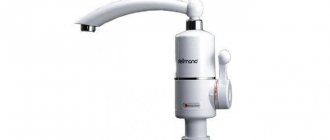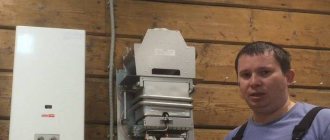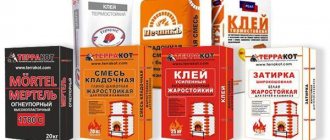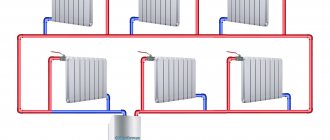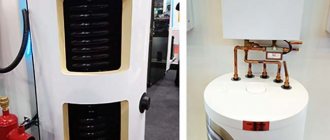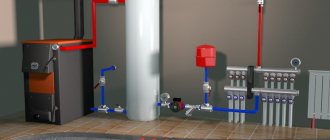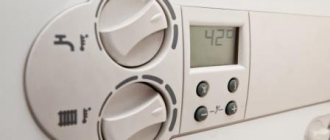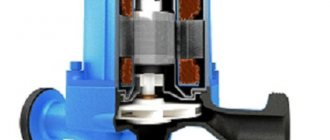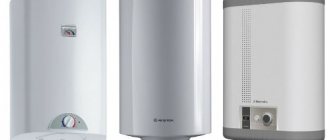A water heater is the most important equipment in a house where there is no centralized water supply. The constant need for hot water forces us to purchase expensive appliances that often break down. Of course, you can heat water in the old proven way - on the stove in a saucepan. But, if there are small children, pets, or pensioners in the house, then this method is very labor-intensive.
To make a person's everyday life easier, a storage boiler was invented, which consists of a heater, a small pump, and a storage barrel. Both floor-mounted and wall-mounted, the unit takes up a lot of space. Moreover, a storage heater has a clear disadvantage for summer residents - if you come rarely, then in winter the water inside will simply freeze, which will lead to its breakdown.
When comparing water heating equipment in terms of price and performance, the electric heater comes first, since it is the safest to use. Gasoline, gas and wood burners consume a large amount of fuel, so their use is not always rational.
How to make it yourself
Typically, boilers operate from the mains and are wired to a mixer.
But how can you save money? So what should summer residents, gardeners and simply lovers of summer holidays in the countryside do? For those who like to do something with their own hands or have a technical education, it will not be difficult to make a flow-through boiler.
The simple design itself is repairable and productive - all this is possible for budget money. A homemade instantaneous boiler is installed by bending the spiral of a pancake around an electric stove or gas burner.
To make a water heater at home you will need:
- The pipe is made of copper, since copper is an excellent heat conductor. Sometimes they use nichrome wire, winding it several times.
- Rubber hose (preferably new).
- Rubber gaskets matching the diameter of the hose and metal clamps.
In order to do everything correctly and safely, you need to familiarize yourself with the technical documentation of the electric (gas) stove and determine its potential.
Progress:
- Measure the diameter of the electric stove or burner pancake.
- Bend the copper pipe into a spiral with a diameter slightly larger than the diameter of the stove so that the spiral outlets protrude 20-30 cm from the stove. It is necessary that the spiral fits tightly to the base of the slab and does not have any distortions. Make sure the spiral has straight, smooth edges.
- Secure the spiral using the brackets and bolts (you can use another fastening hardware to secure it).
- Connect a rubber hose to the spiral outlets and secure it with a metal clamp.
- Connect the other end of the hose to the faucet and install it along the sink.
- Turn on the water and check the operation of the system for leaks.
If the coil overheats, do not turn on the water - this can lead to rupture of the metal. Turn off the gas (electricity) and give the metal some time to cool.
In order to control the temperature of water from an instantaneous water heater, you can install a bimetallic plate from a conventional oil boiler or iron on it. It's inexpensive, but it solves a lot of problems. And thanks to the convenient handle, even a child can make adjustments.
All parameters can be varied, since, in fact, a homemade boiler is based on the potential and capabilities of a gas or electric stove.
What materials will be needed to create an electric flow heater?
How to make a instantaneous water heater with your own hands, powered by electricity? The process of assembling a tubular unit powered by a heating element will be described. In this case, a heating element with a thermostat for heating water has a power of 4 to 6 kW.
You will need:
- a piece of steel pipe into which a heating element will fit with a small margin;
- two half-inch pieces of steel pipe, which have a standard thread on one end;
- pieces of steel in sheets, the thickness of which is 3 mm;
- nut and bolt for grounding;
- anti-corrosion paint.
Boiler advantages
There are undeniable advantages of a boiler, let’s consider them:
- Temperature sensor that works automatically. In the event of a malfunction, it simply turns off. If we look from the point of view of fire safety, then, of course, the industrial boiler wins, since it is equipped with several types of interlocks. But if we consider the situation with a homemade one, then everything is at your discretion.
- Water flow sensor and pressure sensor. Of course, the boiler neutralizes pressure drops, withstands water hammer, and also easily copes with high water pressure. Saving water with a boiler is only beneficial if it is small in size. For example, a 50-liter boiler consumes a sufficient amount of electricity, so the savings on water are practically unnoticeable. As soon as insufficient pressure appears in the water supply system (less than 0.6 bar), the boiler automatically turns off. As for the instantaneous water heater, even with a minimum water flow, the number of liters of water flowing per minute is about 1.5 liters.
There are instantaneous water heaters on sale that have industrial assembly and a quality guarantee.
They are fixed in place of the tap and have a presentable appearance. For added safety, the chassis must be grounded as the equipment is powered.
More expensive models come with a shower head, which is very convenient for summer residents. But, unfortunately, the price of such a device is very impressive.
If you attach a pan or any large container to a flow-through heater, it will also become storage. To screw in the hoses, use a brass nipple.
Installing a metal articulated crane will greatly simplify the operation of the drive. Without a tap, it will look more like a washbasin, which is very impractical. Pay attention to the tightness of the drive (the lid must be welded with argon welding) and the entire structure as a whole. Insulate the hull and make it safer.
When using a storage flow heater, pay attention to the meter readings: in rural areas the maximum power is about 4 kW.
If an ordinary electric kettle draws 1.5 -2 kW, and a TV draws 1 kW, then you can already calculate which electrical appliances can be turned on at the same time and which cannot. If the meter is automatic, then it will simply blow out the plugs, as fuses will trip, which can be replaced. But if your meter does not have fuses, then turning on the water pump, electric stove and TV at the same time can cause a fire in the wiring.
We make a flow-through water heater from nichrome
It seems like a paradox - we shorten the length of the spiral, and more power is released. There is logic - small is not strong. Let's watch. The thermal effect according to the Joule-Lenz law is equal to the product of voltage and current. The first value is constant (this is an ideal case, but for apartments it is approximately correct), the second parameter is adjusted. We double the current, we get double the power. Try to remember when the plugs burn out. When do we turn on the long spiral? Yes, power 2 kW. Here it is already intuitively clear that it is not enough.
Developers calculate the thermal operating conditions of nichrome wire and take an amount that can work for a long time. It is necessary to satisfy the conditions for energy dissipation through the surface bounding the spiral.
We reduce the number of turns by 2 times, we get 4 kW, the shield breaks, the “bugs” fly out, the light goes out. Eureka. Why do “stupid” designers sometimes make two 2 kW spirals instead of reducing the number of turns? Let's watch! Heat loss depends on temperature differences between the surface and the environment. Doubling the power is equivalent to doubling the temperature. But the scattering surface has also become half as large, so it’s already 4. If it was 200 degrees Celsius, it will become 800. At this temperature, aluminum already becomes a liquid.
Due to the temperature conditions, it is not recommended to make too powerful spirals. Nichrome holds the temperature well, but fades in air. Let's take nichrome wire and make a 6 kW instantaneous water heater, but with three spirals so that there is no fire and the device works properly. Along the way, let’s calculate the approximate size of the device. Why is a copper tube used as a core? Due to the high thermal conductivity of the material. The lion's share of energy goes into the water, not into the air.
DIY passive solar water heater: device diagram
A solar water heater is a device for which there is no need to connect to electricity and use pumps to circulate water. The simplest unit, often used for a summer shower or homemade plumbing, is a large metal tank filled with water. During the day, the water in it can heat up to 40 degrees. Thanks to the pipe layout, you can run water both into the shower and into the kitchen.
By using solar energy to heat water, you can significantly save on the electricity or gas required for a tankless water heater.
Passive solar water heater needs to be installed in an open area
The solar convector consists of a storage tank, water pipes, a heat absorber and a heat exchanger. For domestic needs, a 200 liter tank and a solar convector with an area of 2-2.5 sq.m. are sufficient. Such a device can heat a sufficient amount of water in a couple of sunny hours.
Scheme of working on a solar convector:
- Weld seamless pipes together to form a lattice. By welding, attach it to a sheet of durable steel and cover it with black paint.
- Make a frame from moisture-resistant plywood and attach it to a steel sheet, cutting holes in the frame for pipes.
- Insulate the pipes and cover the collector with glass, connecting the parts with silicone. Also coat the free space between the frame and the glass with silicone.
- Bend the copper pipe in a spiral, bringing its edge out. Insulate the tank for better heat retention.
- Place the manifold in place and connect it to the cold and hot water pipes. Install the expansion tank when hot water enters the tank.
To check the boiler for functionality, you need to fill the tank with water, pour water into the convector system. When water heats up, it will rise up and fill the tank, and cold water will flow from it into the system.
A man gets hot water from a thermosiphon and a wood stove
The cold winter season increases the demand for hot water. Instead of installing an expensive water heater in your home, a more economical option is to use a wood stove to heat your water. This way, you won't have to incur huge electricity bills just to get your water heated.
In this DY video, you'll learn a simple, safe, and effective way to use a furnace to heat water in your home. This method uses the laws of convection in a thermosyphon, so all you need to do is repeat the idea stated in the article.
Heated water can be expensive, especially if you do it using a purchased heater. If you want to reduce heating costs, you can use a wood-burning stove. The video below will show you how to do this. Many thanks to YouTube host "convectioncoil.com".
DIY electric and gas water heater
Today on sale you can find various devices designed to heat water. They differ in operating principle and cost. But it’s not at all difficult to make a water heater with your own hands. A homemade unit will be relevant for private households, where problems often arise with electricity or installation of a gas boiler. There are several available methods of heating water, each of them has its own advantages and disadvantages.
A water heater is a device designed to transform various types of energy into heat, which is then transferred to a coolant, which is water. The industry offers various options for such devices. The source of heat in them can be electricity, gas, solid or diesel fuel. Along with this, alternative energy sources - sun and wind - are also becoming popular.
All heating systems on the market are divided into two types:
The design of the former involves the use of a tank in which a certain temperature is maintained. When you open the tap, cold water flows into a sealed container, and hot water is squeezed out into the pipeline. Thus, in the middle of the tank there is always a certain amount of heated coolant. Storage units are distinguished by their size and long-term heating of water. Their use is justified in systems with a large number of water intake points. The devices are available with tank volumes from 10 to 200 liters.
Flow devices have a completely different operating principle. In them, water is heated only when it circulates, that is, when the tap opens. Their advantage is their small size and easy installation. One of the significant disadvantages is the large power required to quickly heat water.
Moreover, if several water intake points are used simultaneously, the tank will not be able to provide uniform heating and the temperature of the coolant will begin to change abruptly. In practice, it will take from 30 seconds to 2 minutes for water to flow from the tap at normal temperature.
This design is used both in the private sector and apartment buildings. The main part of such a device is a storage tank placed inside the housing. Between them there is a layer of heat insulation necessary to save energy resources. The water storage container is made of various metals: enameled or stainless steel, copper.
The coolant is heated using a gas burner located at the bottom of the tank or an electric heating element (TEH). But there are also products that use a water or steam exchanger to maintain the coolant temperature.
Hot water constantly circulates in a closed system, and it is heated using a heating boiler. This type of operation is called indirect heating.
In addition to the tank and heat source, the design of the storage device includes:
- 1. Temperature control device. This is a set of devices designed to maintain the set heating value. Most often, temperature sensors are used, connected to an electronics unit that controls turning the heating system on and off.
- 2. Protection. To avoid an increase in pressure inside the tank resulting from the expansion of heated water, various devices are used. This can be either an additional expansion tank or a safety valve. In addition, depending on the heating source, a set of protective devices is used to prevent gas leakage and current breakdown to the housing.
- 3. Bell Water heaters use two pipes: one serves to supply cold media, and the second serves to dispense hot water.
- 4. Check valve. This small device allows you to store water in the tank, even if there is no water in the supply system. It allows the medium to flow in one direction and prevents it from flowing in the opposite direction.
Boilers can be closed or open. The former are used in conjunction with a centralized water supply system, and the latter are designed to serve one water intake point by shutting off the pipeline water not at the outlet, but at the inlet to the boiler. This is the easiest water heater to make with your own hands.
Stages of work
- Before you begin assembling the electrical structure, you should clean all metal parts using a grinder.
- A metal piece is taken, the size of which is larger than the diameter of the pipe. Holes for installing the heating element are marked in its center. Depending on the model, it can have a power from 1 to 6 kW.
- The fasteners are removed from the heating element and the required drill is selected, which will be 1 mm larger than the device’s leg. This drill makes holes of the required diameter. Some models of heating elements contain a threaded or smooth body designed for insertion into some kind of device. Such a hole is cut using a drill or inverter. You can turn to a professional turner for help.
- If necessary, drill holes for mounting bolts and tap threads. A piece of metal is applied to the end of the pipe so that the holes are in the middle. The shape of the pipe is outlined.
- The metal is cut according to the markings using a grinder. Then another circle is made, only without holes.
- The heating element is fixed in the circle that is intended for it. Make sure that all parts fit snugly together.
- The heating element is removed and welded to the end of the pipe. It should be cut so that there is a distance of 2 cm from the end of the heating element to the second circle.
- Next, an indent of 1 cm is made from each end of the pipe, and a pair of holes are cut in it on the same line. They correspond to the diameter of the threaded sections located inside.
- Threaded sections are welded to the holes. Water will be connected to them.
- A circle with holes is welded under the heating element, and the heater is installed. Then a second circle is welded on the other side.
- A grounding nut is welded in any suitable place.
- The resulting structure is connected to the water supply and tap. This is how the device is checked for leaks. If a leak is detected, it must be repaired.
- The water heater is removed, its surface is degreased and covered with rust-resistant paint.
- After the paint has dried, you can install and connect the device.
This homemade instantaneous water heater is secured using various gaskets and nuts.
